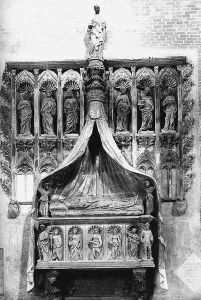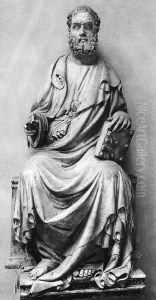Niccolo Di Pietro Lamberti Paintings
Niccolò di Pietro Lamberti, also known as Niccolò di Pietro Gerini or Niccolò Aretino, was an Italian sculptor and architect active during the early Renaissance period. He was born around 1370 in Arezzo, Tuscany, and is often associated with the Florentine school of art. Lamberti's work is noteworthy for its blend of Gothic and early Renaissance styles, reflecting the transitional nature of art during his lifetime.
Lamberti's career is marked by several significant contributions to the architectural and sculptural landscape of his time. One of his most famous works is the series of sculptures he completed for the Orsanmichele in Florence. These sculptures include the figures of Saints Stephen, James, and Peter, which were commissioned by various Florentine guilds to decorate the exterior niches of the building. His work is characterized by a strong sense of realism and an attention to detail, which was innovative for the time and signaled a shift towards the naturalism that would come to define the Renaissance.
In addition to his sculptural work, Lamberti was also involved in architectural projects. He worked on the design and construction of the Loggia dei Lanzi, also known as the Loggia della Signoria, in Florence. This structure is one of the most famous examples of public architecture from the Renaissance and remains a significant landmark in the city.
Despite his considerable talents and contributions, Lamberti's fame was somewhat overshadowed by the works of his contemporaries and successors, such as Donatello and Lorenzo Ghiberti, who are more widely recognized today. Nevertheless, Lamberti's work was influential in its time and provides an important insight into the transitional period between Gothic and Renaissance styles in Italian art.
Niccolò di Pietro Lamberti died around 1451. Although not as well-known as some of his peers, his work continues to be studied and admired for its historical significance and artistic merit. His sculptures, in particular, stand as testament to the skill and creativity of artists during a pivotal moment in the history of art.

